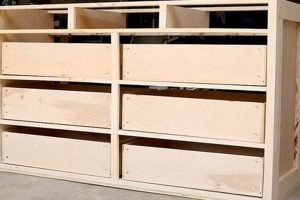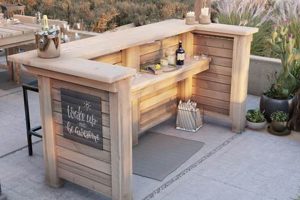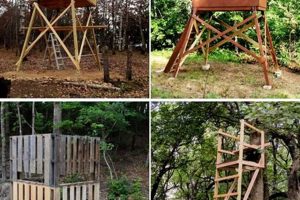The process of creating a decorative garden structure from scratch using self-provided instructions is a popular endeavor for many homeowners. These projects typically involve constructing a miniature well, often featuring a roof, bucket, and crank, to enhance outdoor aesthetics. The availability of detailed guides empowers individuals to undertake this construction independently, often repurposing readily available materials.
Engaging in this activity presents multiple advantages, including cost savings compared to purchasing pre-made items and the opportunity to customize the design to suit individual preferences and garden layouts. Furthermore, it allows for creative expression and the satisfaction of building something unique. Historically, wells held a practical function, but these contemporary adaptations serve primarily as ornamental features, adding a touch of rustic charm to landscapes.
The subsequent sections will explore different design considerations, material options, step-by-step building processes, and finishing techniques applicable to such garden projects. The goal is to provide clear guidance for constructing a durable and visually appealing outdoor feature.
Construction Recommendations
Adhering to specific guidelines can ensure the successful completion of a decorative well project, resulting in a durable and aesthetically pleasing garden feature.
Tip 1: Material Selection: Prioritize weather-resistant materials. Treated lumber, cedar, or composite decking are suitable choices due to their resistance to rot and insect damage. Consider the aesthetic appeal and durability of each material in relation to the local climate.
Tip 2: Foundation Stability: A stable foundation is critical, especially in areas prone to frost heave or shifting soil. Construct a gravel base or concrete footing to provide a solid and level surface for the structure to rest upon. Proper leveling ensures the longevity of the build.
Tip 3: Accurate Measurements: Precise measurements are essential for accurate cuts and a structurally sound build. Double-check all measurements before cutting any materials. A detailed cutting list will minimize errors and material waste.
Tip 4: Secure Fasteners: Utilize galvanized or stainless-steel screws and nails to prevent rust and corrosion. Pre-drill pilot holes before driving fasteners to avoid splitting the wood. Adequate fastening ensures structural integrity.
Tip 5: Roofing Design: Design the roof with a slight overhang to protect the well structure from rain and snow. Consider the angle of the roof to allow for proper water runoff. Durable roofing materials, such as cedar shingles or asphalt shingles, provide lasting protection.
Tip 6: Bucket and Crank System: If incorporating a bucket and crank system, select durable hardware designed for outdoor use. Ensure the rope or chain is weather-resistant and of appropriate strength to support the weight of the bucket. Regular maintenance will extend the lifespan of these components.
Tip 7: Protective Finish: Apply a protective finish, such as paint, stain, or sealant, to enhance the structure’s appearance and protect it from the elements. Choose a finish that is specifically designed for outdoor use and provides UV protection. Regular re-application will maintain its protective qualities.
By adhering to these recommendations, the construction process can be streamlined, leading to a durable and attractive garden ornament.
The subsequent sections will address common challenges encountered during construction and strategies for overcoming them.
1. Design blueprints
Design blueprints are foundational to the successful execution of decorative garden well projects. These detailed schematics serve as the primary link between conceptualization and physical realization, dictating the dimensions, materials, and assembly processes required for the construction of a functional or purely ornamental structure. Without comprehensive plans, the project risks structural instability, inaccurate material estimation leading to waste, and a compromised final aesthetic. A real-life example might involve a homeowner attempting to build a well without a blueprint, resulting in uneven walls, a poorly fitted roof, and eventual collapse due to inadequate support.
The practical significance of utilizing detailed design blueprints extends beyond mere aesthetics. They facilitate accurate cost projections, enabling individuals to budget effectively and avoid unexpected expenses. Moreover, precise plans allow for the pre-cutting of materials, minimizing on-site adjustments and accelerating the construction timeline. The blueprints also serve as a crucial reference point during the building process, ensuring each component is correctly positioned and securely fastened. This approach is particularly beneficial when repurposing materials, as detailed plans allow adjustments for size and shape of recycled pieces to be incorporated smoothly in the design.
In conclusion, design blueprints are an indispensable component of building a decorative garden well. They mitigate risks associated with inaccurate construction, optimize material usage, and ultimately contribute to a durable and visually appealing garden feature. While some may consider omitting this step to save time or resources, the potential consequences of doing so often outweigh the perceived benefits. The detailed planning phase ensures a structurally sound and aesthetically pleasing outcome, directly affecting the longevity and overall value of the project.
2. Material selection
Material selection represents a critical decision point in the execution of self-directed decorative garden well projects. The chosen materials directly influence the structure’s durability, aesthetic appeal, and long-term maintenance requirements. Careful consideration of these factors is paramount for achieving a satisfactory and lasting result.
- Weather Resistance
The susceptibility of materials to weathering significantly impacts the lifespan of the structure. Untreated wood, for instance, is prone to rot, insect infestation, and warping under prolonged exposure to moisture and sunlight. Conversely, treated lumber, cedar, or composite materials offer increased resistance to these elements. Failure to select weather-resistant materials can result in premature degradation and the need for costly repairs or replacement. For example, a structure built with untreated pine in a humid climate may require extensive maintenance within a few years, whereas a cedar well could last for decades with minimal upkeep.
- Structural Integrity
The load-bearing capacity and structural stability of materials must align with the design specifications of the project. Lightweight materials may be suitable for purely ornamental wells, while more robust materials are necessary for functional designs that incorporate a bucket and crank mechanism. The selection of inadequate materials can compromise the structural integrity of the well, leading to collapse or instability. Utilizing pressure-treated posts for the main support structure of the well, for instance, provides a stable and long lasting construction.
- Aesthetic Considerations
Material selection significantly contributes to the overall aesthetic of the decorative well. Different materials offer distinct visual characteristics, ranging from the rustic charm of reclaimed wood to the polished appearance of composite decking. The choice of material should complement the surrounding landscape and reflect the homeowner’s personal preferences. An example could include using river rock to surround the base, as well as selecting a complimentary stain for the structure.
- Cost and Availability
Budgetary constraints and the availability of materials often influence material selection. While premium materials like cedar offer superior durability and aesthetics, they may be cost-prohibitive for some individuals. Exploring alternative materials, such as treated lumber or reclaimed wood, can provide a balance between cost-effectiveness and performance. Local availability of specific materials can also impact project feasibility.
The process of material selection is integral to the success of decorative garden well initiatives. By carefully evaluating the properties, costs, and aesthetic attributes of various materials, individuals can make informed decisions that maximize the longevity, visual appeal, and overall value of their projects. Overlooking this crucial step can lead to structural deficiencies, premature degradation, and ultimately, a disappointing outcome.
3. Foundation integrity
The structural integrity of any constructed element relies heavily on the stability of its base. In the context of “diy wishing well plans,” the foundation forms the crucial interface between the decorative structure and the ground. The adequacy of this foundation directly determines the longevity and safety of the entire build. For instance, improperly prepared ground can lead to settling, resulting in tilting or collapse of the feature over time. Choosing the correct ground preparation and material will assist.
A properly designed foundation addresses several critical concerns. It distributes the weight of the well evenly across the underlying soil, preventing localized pressure points that could lead to subsidence. It protects the base of the well from ground moisture, which can accelerate decay and compromise structural integrity. Furthermore, it resists the effects of frost heave in colder climates, where freezing and thawing cycles can disrupt the ground and displace the structure. Real-world examples might include the use of a compacted gravel bed topped with concrete pavers to create a stable and level platform, or a poured concrete footing extending below the frost line to provide a secure anchor.
The practical significance of understanding foundation requirements extends beyond mere aesthetics. A well-constructed foundation minimizes the need for future repairs and maintenance, preserving the investment made in materials and labor. It ensures the safety of individuals who interact with the structure, preventing potential hazards associated with unstable or collapsing wells. Therefore, meticulous attention to foundation details is an indispensable element of any well-executed “diy wishing well plans,” directly impacting the long-term viability and enjoyment of the garden feature.
4. Roof construction
The design and execution of the roof are integral to the success of any “diy wishing well plans.” The roof serves not only as an aesthetic element but also as a crucial protector of the well structure against environmental elements. Proper roof construction directly impacts the longevity and overall appeal of the finished project.
- Material Selection
The choice of roofing material significantly influences both the visual character and the weather resistance of the well. Options range from traditional wood shingles, offering a rustic aesthetic, to asphalt shingles, providing a more economical and durable solution. Considerations should include the local climate, potential for pest damage, and the overall design aesthetic of the well. A poorly chosen material could lead to premature decay or an incongruous appearance. An example is using cedar shingles which offer good rot resistance and create a classic look. Conversely, using thin, untreated wood in a high-rainfall area would lead to rapid deterioration.
- Structural Integrity
The roof’s framing and support system must be robust enough to withstand wind, snow, and other environmental loads. Properly sized rafters, securely fastened to the well’s structure, are essential for maintaining the roof’s integrity. Failure to adequately reinforce the roof can result in collapse, compromising the entire well. An example includes using properly sized, pressure-treated lumber for the rafter structure, while another might involve using hurricane ties to increase the roof’s resistance to high winds.
- Roof Pitch and Overhang
The roof pitch, or angle, and the overhang, or extension beyond the walls, play critical roles in water runoff and protection of the well structure. A steeper pitch facilitates rapid water drainage, reducing the risk of leaks and water damage. A sufficient overhang shields the walls from rain and sun, preventing weathering and extending the life of the well. For instance, a steeper roof pitch is essential in areas with heavy snowfall, while a generous overhang is particularly important in regions with frequent rain.
- Waterproofing and Sealing
Proper waterproofing and sealing are essential to prevent water intrusion and protect the underlying structure. This can involve the use of roofing felt underlayment, flashing around roof penetrations, and sealant along joints and seams. Inadequate waterproofing can lead to rot, mold growth, and structural damage. A practical example is using self-adhering waterproof underlayment beneath the shingles, which provides an additional layer of protection against leaks. Another would be sealing any gaps around the well bucket rope access point.
In summary, effective roof construction is not merely an aesthetic consideration but a fundamental aspect of ensuring the durability and longevity of wells. The selection of materials, structural integrity, roof pitch, overhang, and waterproofing measures all contribute to a well-protected and visually appealing finished product. Neglecting these elements can result in premature failure and undermine the entire “diy wishing well plans” endeavor.
5. Crank mechanism
The inclusion of a crank mechanism within self-directed decorative garden well projects represents a distinct design choice, transforming the structure from a purely aesthetic ornament into a potentially interactive feature. The presence of a functional crank necessitates careful consideration of engineering principles and material selection to ensure both safe operation and structural integrity. A poorly designed crank system can lead to mechanical failure, rendering the feature unusable or even posing a safety hazard, such as a snapped cable or malfunctioning gears. For example, a crank constructed from low-grade materials may corrode quickly, while an improperly sized or designed crank may be difficult to operate.
The integration of a crank typically involves a rotating handle connected to a spool or drum, around which a rope or chain is wound. This allows for the raising and lowering of a bucket, either for decorative effect or, in some instances, for the retrieval of water. The mechanical advantage provided by the crank mechanism enables users to lift heavier loads with less effort. The functionality extends the life of the well, as the mechanism can also be used to clean or perform other maintenance tasks. This is typically achieved through regular inspections to ensure that metal components are lubricated and that stress forces are not exceeding design specifications. A specific real-world illustration would involve the application of marine-grade grease to lubricate the gears, preventing rust and friction that impede smooth operation.
In conclusion, the presence of a crank mechanism in such projects increases the complexity of the build but also adds a dimension of interactive engagement and historical authenticity. Careful planning, material selection, and construction techniques are paramount to ensure both functionality and safety. Successfully incorporating this element can elevate the overall design and appeal of the garden feature. However, a lack of attention to detail can result in a non-functional or even hazardous outcome, ultimately detracting from the project’s intended aesthetic and practical value.
Frequently Asked Questions
The following questions address common concerns and misconceptions regarding the design and construction of garden structures, providing clarity on key aspects of the building process.
Question 1: What considerations are paramount when selecting materials for a garden structure?
Material selection must prioritize weather resistance, structural integrity, and aesthetic compatibility with the surrounding environment. Durable materials, such as treated lumber or cedar, are recommended for longevity.
Question 2: How crucial is a detailed design blueprint?
A detailed design blueprint is essential for accurate material estimation, precise cutting, and ensuring structural soundness. It minimizes waste and facilitates efficient construction.
Question 3: Why is proper foundation preparation necessary?
Proper foundation preparation prevents settling, tilting, and collapse of the structure. A stable foundation distributes weight evenly and protects against ground moisture and frost heave.
Question 4: What factors influence the choice of roofing material?
The choice of roofing material depends on climate, budget, aesthetic preferences, and structural requirements. Durable, weather-resistant materials are recommended to protect against water damage and UV exposure.
Question 5: How does the design of a roof impact functionality?
Roof pitch and overhang affect water runoff and protection of the underlying structure. A steeper pitch facilitates drainage, while a sufficient overhang shields walls from rain and sun.
Question 6: What are the key considerations for incorporating a functional crank mechanism?
Integrating a crank mechanism requires careful attention to material selection, mechanical design, and safety. Durable hardware and a well-engineered system ensure smooth operation and prevent mechanical failure.
These responses provide a framework for addressing common challenges and misconceptions. Adherence to these principles enhances the likelihood of a successful outcome.
The subsequent sections will explore advanced design techniques, including incorporating sustainable practices and integrating smart technologies.
Concluding Remarks on Decorative Well Projects
This exploration of decorative well projects has underscored the importance of meticulous planning, informed material selection, and sound construction practices. Design blueprints, foundation integrity, roof construction, and mechanism implementation are all elements that contribute to a successful, durable, and aesthetically pleasing garden feature.
The information presented serves as a framework for individuals seeking to enhance their outdoor spaces through independent building. The application of this knowledge will lead to the creation of durable, long-lasting structures that enhance the visual and aesthetic value of their landscaping.



![Best DIY Slide In Truck Camper Plans [Easy Build Guide] The DIY Hub: Creative Crafts, Repairs & Life Hacks Best DIY Slide In Truck Camper Plans [Easy Build Guide] | The DIY Hub: Creative Crafts, Repairs & Life Hacks](https://craftingdiycenter.com/wp-content/uploads/2025/07/th-1432-300x200.jpg)



